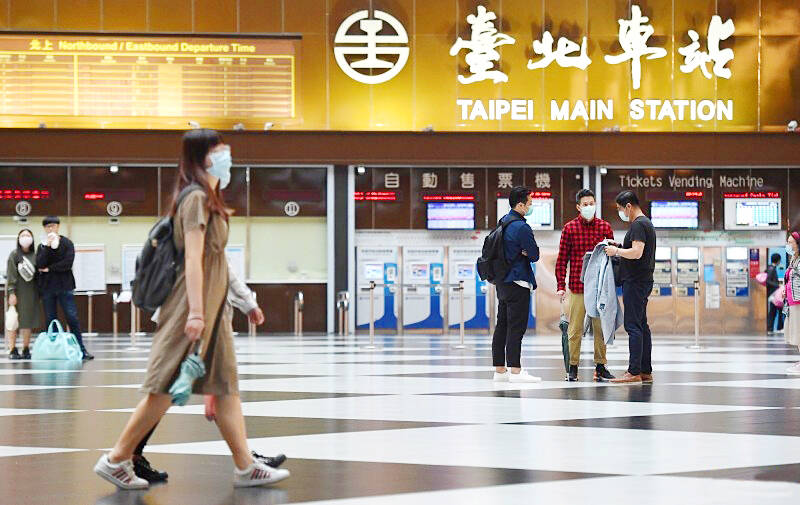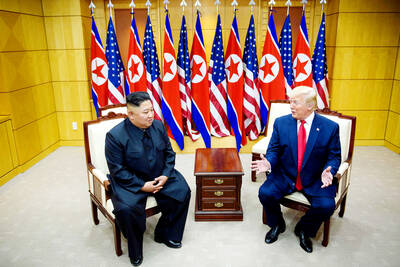The pandemic is over, beaches beckon and airline bookings are brimming with leisure travelers powering the industry’s rebound from the COVID-19 abyss.
But with the return to flying comes a reminder of its considerable contribution to global warming. Aviation accounts for some 2.1 percent of CO2 emissions, a share that is set to rise as other industries decarbonize more quickly. Global jet-fuel demand is projected to pass 2019 levels next year, according to BloombergNEF.
For now, there’s no real way to get around the environmental impact. In an ideal world, commercial aircraft would be powered by fossil-free alternatives to the kerosene used in today’s jet engines — but battery power, e-fuels and hydrogen propulsion will take decades, if ever, to reach scale.

photo: Taipei Times file
Carbon offsets, promoted by airlines as a way for travelers to cleanse climate guilt, have been shown to be largely ineffective. So-called sustainable aviation fuels, touted as a first step to clean up the industry, are expensive and in minimal supply. Their effectiveness varies with choice of feedstock and other factors.
FLY LESS
Which is why climate-change campaigners have a more straightforward approach: people just need to fly less.
“The best option would be not to travel at all,” said Matteo Mirolo, aviation manager at Brussels-based sustainability advocacy group Transport & Environment. “Second best is, of course, take another mode of transportation, which enables you to travel with a much more limited climate impact.”
Mirolo’s group lobbies for government policies that will make less-polluting transport options more competitive. Europe is ahead of other regions in some ways — it is expanding rail networks, and big businesses have largely kept to pledges to fly less.
Governments have taken limited steps — France has banned a handful of domestic flights to promote trains, and the Dutch state wants to limit flights from its Amsterdam hub, for example. But for now, it’s up to leisure travelers to find alternatives.
Beyond cycling, hiking and other sweat-inducing activities, here are some ideas for travelers to lower their carbon footprint this summer.
HIGH-SPEED RAIL
In Europe, a growing high-speed rail network presents a real alternative to flying between many major cities, offering competitive travel times with much lower carbon-emissions impact. Spain, France, Germany and Austria are among the countries investing to expand services. Links across borders are still a snag, as government-owned systems are optimized for domestic travel.
Resourceful travelers can tap their inner Marco Polo to find a host of multi-country options. The Rome2Rio site has a useful tool.
For a simple plan, there’s the pioneer of international high-speed rail, Eurostar, which connected London with Paris, Brussels and Lille in 1994, adding Amsterdam in 2020.
Paris makes a good starting point for a longer trip as well. There’s an extensive high-speed French network, with trains to Bordeaux, Marseille and Strasbourg, and access to Zurich, Milan, Barcelona, and Frankfurt. A fast link with Berlin is in the works.
The potential for rail travel is limited by the networks themselves — another reason planes and cars won’t be replaced soon. Train travel is more complicated, requiring flexibility and some creativity in vacation planning.
The hassles tend to multiply over longer distances and across borders. One approach is to combine faster trains with more-scenic routes. A one-week itinerary could take in France, Switzerland and Italy, for example, or traverse Hungary, Slovakia, Vienna and Lake Bled in Slovenia.
Rail operators have also added a slew of overnight trains, which can save on hotels and minimize the inconvenience of longer-distance journeys. Austria’s Nightjet has recently overhauled rolling stock that includes sleeper cabins with showers.
For one example, a night train departing Munich at 8:09pm arrives in La Spezia, gateway to Italy’s Cinque Terre, at 11:10am the following day. The trip’s carbon impact is about one-fourth of the more typical approach: flying to Genoa, then renting a car, according to calculations from the Ecopassenger.org Web site.
There are luxurious options like the Venice-Simplon Orient Express, with destinations as far as Prague, Budapest and Istanbul, or the Golden Eagle Danube Express, a hotel train whose itineraries range from the castles of Transylvania to Budapest. In Switzerland, the Glacier Express is among the lines traversing the panoramic bridges, tunnels and gorges of the Alps and whisks travelers to upscale resorts like St Moritz, so you can leave the private jet at home.
ONLY VISIT ONE COUNTRY
A simpler approach is to stay within a given country.
Spain now boasts the most extensive high-speed rail network of any country except China. In the fourth quarter, the Barcelona-Madrid link carried 35 percent more riders than a year earlier, while the number from Madrid to Valencia doubled. Traffic on both routes was 40 percent or more above pre-pandemic levels, according to government figures.
Indeed, where competitive alternatives to flying exist, travelers are willing to use them. Between London and Paris, Eurostar has steadily displaced airlines, with 77 percent of passengers last year choosing trains over planes, according to Eurotunnel operator Getlink. (The figures exclude those traveling in cars, which can cross the English Channel by ferry or on railcars through the Channel Tunnel.)
Last summer, 57 percent of passengers between London and Edinburgh chose rail over air travel, up from 35 percent pre-pandemic, according to Lumo, which began serving the 4 1/2-hour route in 2021.
There’s also the classic road trip, re-imagined for a new generation of electric automobiles. Range anxiety is still a concern, with charging networks sparse in many countries. An exception is in Norway, an early adopter of battery-powered cars. Charging stations are everywhere, giving e-travelers peace of mind.
For a family trip, a good starting point is Oslo. Pick up an all-electric Volkswagen ID.4 from a car-rental outlet and embark on a 1,050-mile loop that crosses the Trollstigen, a zig-zagging mountain pass with great views, and the country’s scenic southern coast.
While driving an ID.4 generates no CO2, a conventionally powered Ford Kuga SUV with a 1.5-liter engine would produce about 255kg of carbon emissions on the same route.
Sometimes there’s no other way to get there than flying. While long-distance trips make up about one-third of all aviation emissions, there’s a way to lower your impact, for example, by forgoing the comfort of premium seats on a transatlantic journey. Business and first class cabins use more space per passenger, giving them a higher share of a flight’s emissions.
One person flying an economy round trip between London and New York on a Boeing 787-9 produces about as much carbon dioxide as 70 trees can absorb in a year, based on calculations from advisory firm Encon and an online tool built by German non-profit Atmosfair.
Still, that’s less than half of the pollution caused by a first-class fare. Each passenger’s emissions on those flights nearly match the annual carbon dioxide output of an average human in France. (And private jets are 10 times more polluting than commercial flight.)

US President Donald Trump may have hoped for an impromptu talk with his old friend Kim Jong-un during a recent trip to Asia, but analysts say the increasingly emboldened North Korean despot had few good reasons to join the photo-op. Trump sent repeated overtures to Kim during his barnstorming tour of Asia, saying he was “100 percent” open to a meeting and even bucking decades of US policy by conceding that North Korea was “sort of a nuclear power.” But Pyongyang kept mum on the invitation, instead firing off missiles and sending its foreign minister to Russia and Belarus, with whom it

Many people noticed the flood of pro-China propaganda across a number of venues in recent weeks that looks like a coordinated assault on US Taiwan policy. It does look like an effort intended to influence the US before the meeting between US President Donald Trump and Chinese dictator Xi Jinping (習近平) over the weekend. Jennifer Kavanagh’s piece in the New York Times in September appears to be the opening strike of the current campaign. She followed up last week in the Lowy Interpreter, blaming the US for causing the PRC to escalate in the Philippines and Taiwan, saying that as

When Taiwan was battered by storms this summer, the only crumb of comfort I could take was knowing that some advice I’d drafted several weeks earlier had been correct. Regarding the Southern Cross-Island Highway (南橫公路), a spectacular high-elevation route connecting Taiwan’s southwest with the country’s southeast, I’d written: “The precarious existence of this road cannot be overstated; those hoping to drive or ride all the way across should have a backup plan.” As this article was going to press, the middle section of the highway, between Meishankou (梅山口) in Kaohsiung and Siangyang (向陽) in Taitung County, was still closed to outsiders

The Chinese Communist Party (CCP) has a dystopian, radical and dangerous conception of itself. Few are aware of this very fundamental difference between how they view power and how the rest of the world does. Even those of us who have lived in China sometimes fall back into the trap of viewing it through the lens of the power relationships common throughout the rest of the world, instead of understanding the CCP as it conceives of itself. Broadly speaking, the concepts of the people, race, culture, civilization, nation, government and religion are separate, though often overlapping and intertwined. A government